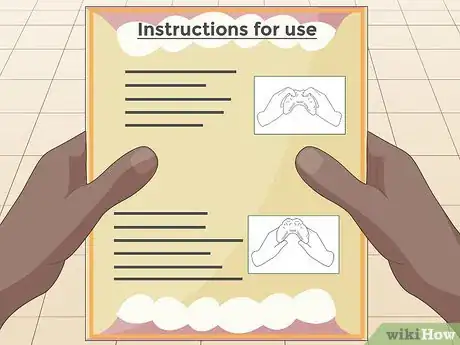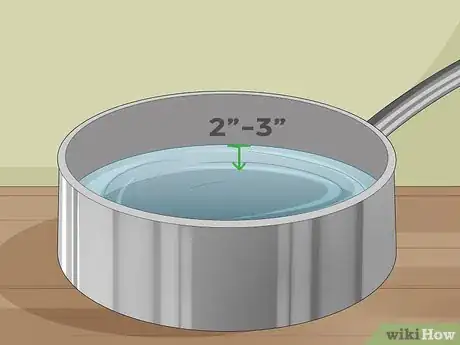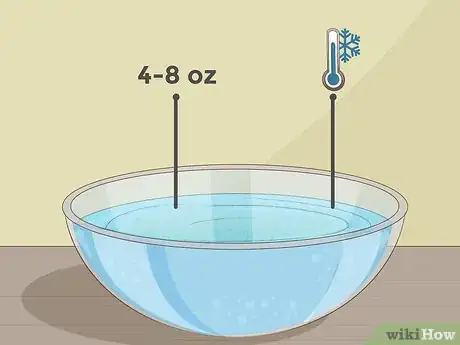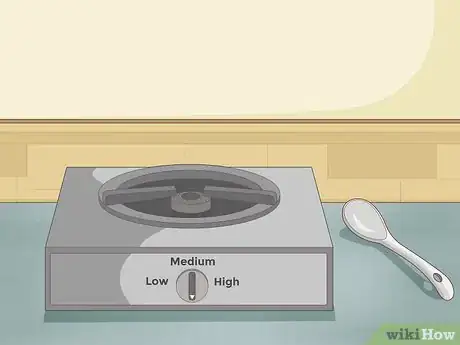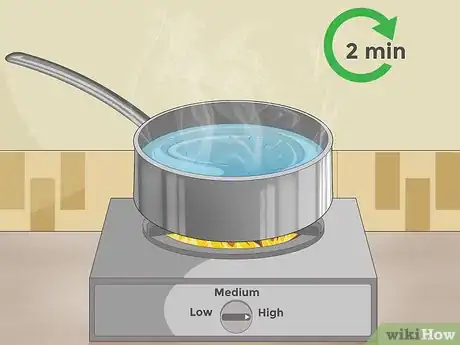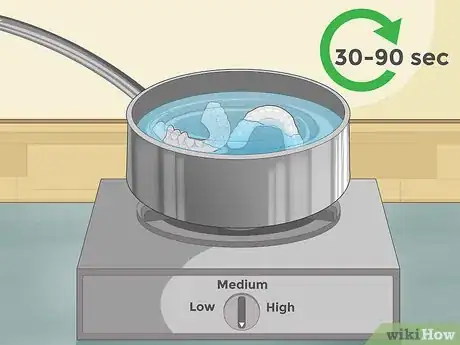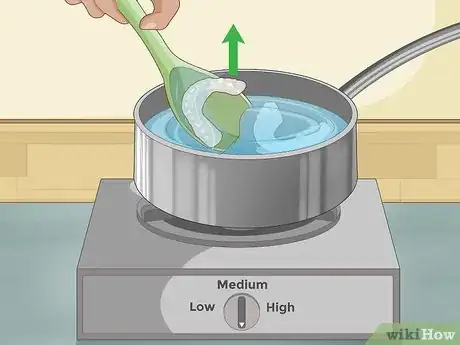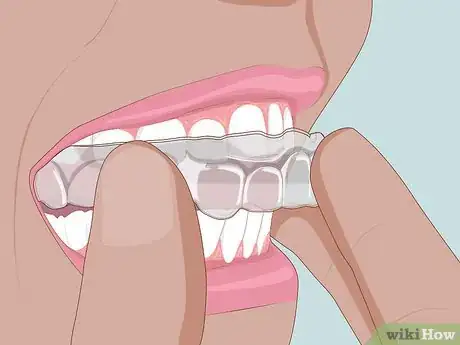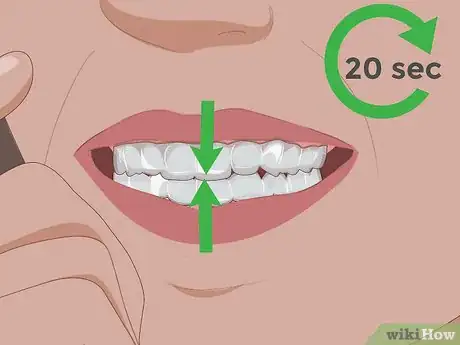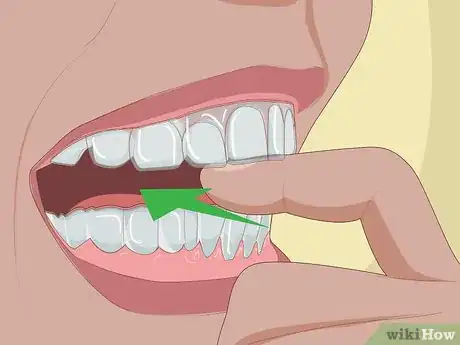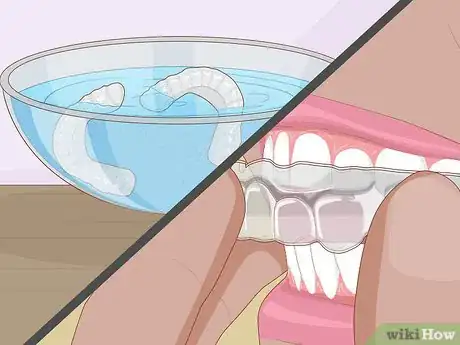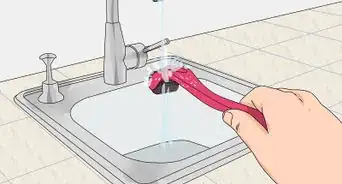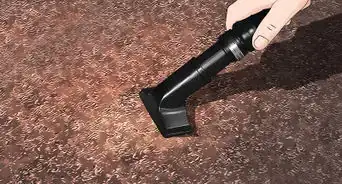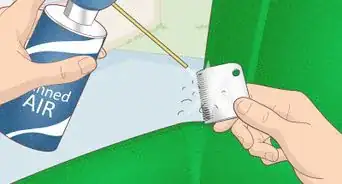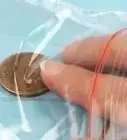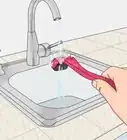This article was co-authored by wikiHow staff writer, Danielle Blinka, MA, MPA. Danielle Blinka is a Writer, Editor, Podcaster, Improv Performer, and Artist currently living in Houston, TX. She also has experience teaching English and writing to others. Danielle holds a Bachelor of Arts in English, Bachelor of Arts in Political Science, Master of Arts in English with a concentration in writing, and Master of Public Administration from Lamar University.
This article has been viewed 19,316 times.
Learn more...
Boil and bite mouthpieces are made out of a thermoplastic material that you can heat up and mold.[1] There are 2 types of boil and bite mouthpieces, including mouthguards for sports and nocturnal bite guards for sleeping. Both types of mouthpieces protect your teeth from damage. You can shape your mouthpiece to fit your mouth by boiling it. However, never boil a mouthpiece to clean it, as this can damage it.
Things You Should Know
- Boiling your mouthpiece will soften it so you can mold it to your mouth, giving you a perfect fit.
- Bring 3-4 inches of water to a boil in a small saucepan and turn off the heat, then drop in your mouthpiece.
- After about 30-60 seconds, carefully remove the mouthpiece with tongs, then drop it into a bowl of cold water for 2 seconds.
- Place the mouthpiece in your mouth while it's still warm and bite down firmly for 20 seconds to shape it to your teeth.
- To set the shape, rinse the mouthpiece in cold water for about 20 seconds, then put it back in your mouth to make sure you're happy with the way it fits.
Steps
Setting up Your Work Area
-
1Read and follow the instructions that came with your mouthpiece. Although the process for molding mouthpieces is similar no matter what type you have, each particular model will have its own guide for shaping the mouthpiece. Make sure you understand the instructions before you begin molding yours.[2]
Tip: Double check how long the manufacturer recommends heating the mouthpiece. If you leave your mouthpiece in the boiling water for too long, it will get damaged. Similarly, taking it out too soon will make it hard to mold it.
-
2Add 3 to 4 inches (7.6 to 10.2 cm) of water to a saucepan. You only need enough water to cover the mouthpiece. Using too much will make it take longer for the water to boil. Additionally, you’ll have a harder time removing the mouthpiece from deeper water.[3]
- You can always place the mouthpiece in the saucepan, then run cool water over it. Just remove the mouthpiece from the pan before you heat the water.
Advertisement -
3Fill a small bowl or cup with 4 to 8 fluid ounces (120 to 240 mL) of cool water. Use a bowl that’s large enough to hold the mouthpiece. Later, you’ll use this water to cool down the mouthpiece before you put it in your mouth.[4]
- The mouthpiece will be very hot when you take it out of the boiling water, and you don’t want to accidentally burn your mouth.
-
4Place a pair of tongs or a spoon next to the stove. You’ll need a utensil to remove the mouthpiece from the water without getting burned. Tongs work best because they’ll grasp the mouthpiece. However, a large spoon will also work.[5]
- If you’re using a spoon, use a slotted spoon for best results. The holes will make it easier to remove the mouthpiece without collecting water.
Softening the Mouthpiece
-
1Bring the saucepan of water to a boil over high heat. The water should start to boil quickly since it’s not very deep. Watch for bubbles to rise from the bottom of the pot up to the surface. When the water is steadily boiling, turn off the pot.[6]
- Don’t leave the saucepan unattended while it’s on the stove.
Variation: You can also boil water in the microwave, if you prefer. Put the water in a microwave-safe bowl, then heat it for 2 minutes. If it isn’t boiling, you could heat it for up to 1 more minute.
-
2Place the mouthpiece in the water for 30-60 seconds to soften it. Drop the mouthpiece into the water, being careful not to splash. Set a timer or watch the clock to make sure you don’t heat the mouthpiece for too long.[7]
- Don’t heat the water for longer to 90 seconds, or it might ruin the mouthpiece.[8]
-
3Use tongs or a spoon to remove the mouthpiece from the water. Turn off the heat, then reach your tongs or spoon into the boiling water. Slowly lift the mouthguard out of the water and transfer it to the bowl or cup of cool water. Be careful not to burn yourself.[9]
- Don’t hover your face over the steam, as it may burn your skin.
-
4Dip the mouthpiece in cold water for 2 seconds to cool it. Submerge your mouthpiece in the cool water for a few seconds, then quickly remove it. This will cool down the mouthpiece so it doesn’t burn your mouth. However, don’t leave it in the water for too long, as the mouthpiece may cool down too much for you to shape it.[10]
- After you remove the mouthpiece from the water, it’s a good idea to touch it carefully with your finger to make sure it’s not too hot to put it in your mouth. If it is, you can dip the mouthpiece a second time.
Shaping the Mouthpiece
-
1Place the mouthpiece in your mouth. Open your mouth wide and slide the mouthpiece inside. Then, bring your lower jaw slightly forward so it’s in line with your top jaw. Next, close your jaw and press your teeth together gently.[11]
- The mouthpiece will be soft and pliable, so don't bite down on it several times. Each time you bite down, your teeth will leave an imprint in the mouthpiece. It's best to bite down just once.
-
2Bite down on the mouthpiece for 20 seconds to shape it. When the bite feels comfortable for you, bite down hard and wait at least 20 seconds for the material to mold around your teeth. Keep your jaw locked and avoid shifting your teeth around so you end up with an accurate shape.[12]
- If your mouth feels uncomfortable, try to adjust your bite so it feels better. If the mouthpiece isn’t soft anymore, boil it a second time so you can try again.
-
3Press your finger and tongue against the mouthpiece as you bite down. This will help you shape the mouthpiece. Use firm pressure to mold the mouthpiece around your teeth. Your finger can shape the outside of the mouthpiece, while your tongue will shape the inside.[13]
- Don't shift your teeth or release your bite as you do this. Biting down on the mouthpiece is most important for shaping it.
-
4Rinse the mouthpiece in cold water for 20 seconds, then check the fit. Put the mouthpiece under cold running water or dip it into an ice bath. After 20 seconds, the mouthpiece should hold its shape. Place it in your mouth to check the fit.[14]
- If it doesn’t fit, you can start the process over and try again.
Tip: Your mouthpiece may occasionally lose its shape or start to feel uncomfortable. If this happens, you can use this process to reshape it. Read the instructions that came with your mouthpiece to see if there’s a limit to the number of times you can shape it.
Things You’ll Need
- Saucepan
- Bowl
- Water
- Ice bath (optional)
- Stove
- Microwave (optional)
- Tongs or spoon
- Mouthpiece
Warnings
- Never leave your stove unattended while it's in use.⧼thumbs_response⧽
- Be careful when handling boiling water and when placing the warm mouthpiece in your mouth. You don't want to accidentally burn yourself.⧼thumbs_response⧽
References
- ↑ https://my.clevelandclinic.org/health/articles/10910-mouthguards
- ↑ https://mouthguardawareness.info/guides/how-to-boil-a-mouthguard/
- ↑ https://mouthguardawareness.info/guides/how-to-boil-a-mouthguard/
- ↑ https://mouthguardawareness.info/guides/how-to-boil-a-mouthguard/
- ↑ https://www.youtube.com/watch?v=qSr5IgGV5bo&feature=youtu.be&t=46
- ↑ https://www.youtube.com/watch?v=qSr5IgGV5bo&feature=youtu.be&t=21
- ↑ https://www.youtube.com/watch?v=qSr5IgGV5bo&feature=youtu.be&t=34
- ↑ https://mouthguardawareness.info/guides/how-to-boil-a-mouthguard/
- ↑ https://www.youtube.com/watch?v=qSr5IgGV5bo&feature=youtu.be&t=46
- ↑ https://mouthguardawareness.info/guides/how-to-boil-a-mouthguard/
- ↑ https://my.clevelandclinic.org/health/articles/10910-mouthguards
- ↑ https://my.clevelandclinic.org/health/articles/10910-mouthguards
- ↑ https://my.clevelandclinic.org/health/articles/10910-mouthguards
- ↑ https://my.clevelandclinic.org/health/articles/10910-mouthguards
